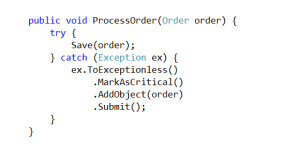We have all worked on projects, large and small, where tiny, one-off bugs went unnoticed for a while before they were finally reported by a user or discovered by a developer. In some instances, these bugs probably affected the end-user's ability to use the service, purchase an item, etc, meaning that there was a direct impact on the bottom line.
What if you didn't have to worry about .NET exceptions going unnoticed anymore?
Enter real-time .NET exception reporting #

What .NET developers needed was a tool that focused on error reporting by logging, grouping, and sending notifications. They needed flexibility through custom objects and a fluent API. They needed every error detail presented in a organized, readable manner. The even needed charts that clearly showed their progress in squashing the tens, hundreds, or thousands of daily exceptions that they didn't know they were occurring.
We needed all that, too, so we built a tool that does it all for us!
What a .NET exception reporting tool has up its sleeves #
When we set out to build Exceptionless, we went through hundreds of possible features, and even toyed with building a larger product that including other functionality, but in the end we decided we wanted it to do the following things really well.
- Send error notifications
- Group exceptions intelligently into stacks
- Show top errors and allow them to be prioritized
- Provide detailed error reports, including stacktrace
- Have a dashboard with an immediate view of error statistics and trends
- Allow custom objects to be added to reports
- Allow unlimited users per organization
- Give developers a way to **mark exceptions critical, fixed, or **monitor for regressions
- Provide real-time updates, as exceptions happen
- Support offline usability in scenarios where the developer is traveling, etc
- Be able to be installed in less than 5 minutes
Why Exceptionless is a must-try for .NET developers #
You should give it a shot if:
- Finding that bug 2 weeks sooner could have saved you or your company a lot of money
- Customers were lost because of a bug on production that you couldn't see locally or in the development environment
- You fixed a bug in one spot, only to find out that it was happening in several other places as well
- There might be errors here or there, but they probably aren't affecting very many users (hint: they probably are).
- You or your team are making a lot of changes in the next sprint, and you really want to make sure you know when a bug gets introduced
- and the list goes on...
And of course, we're here to help!
If you have any issues or questions, just let us know! You can contact us here on the website, or via the support button on your Exceptionless dashboard.
